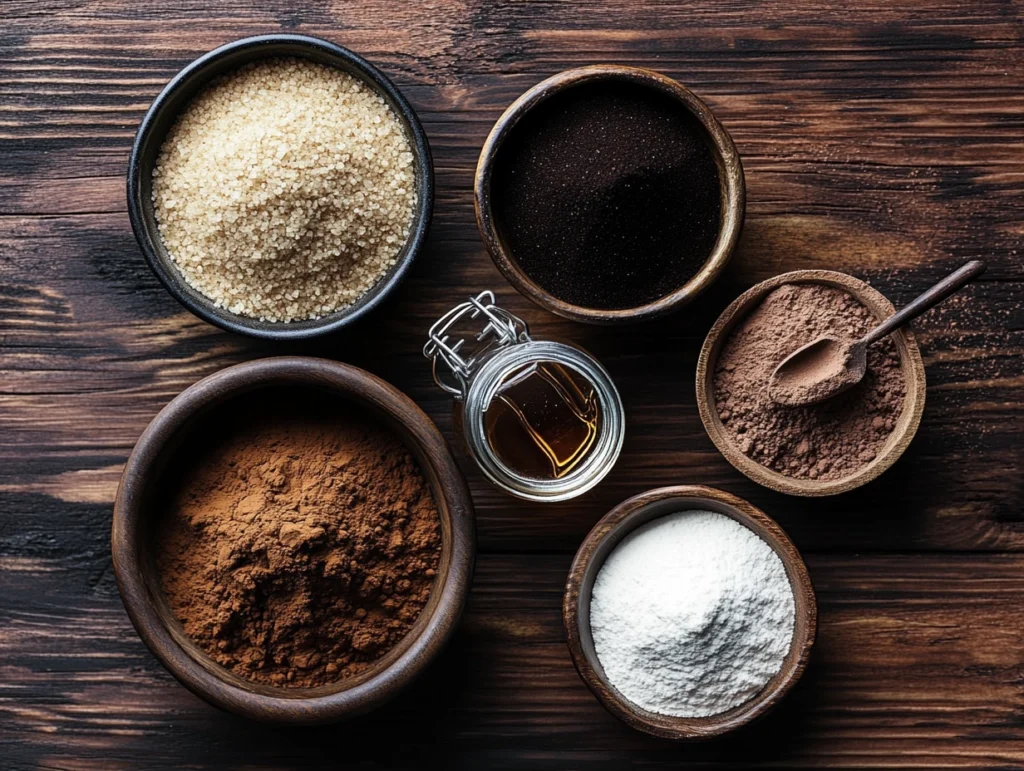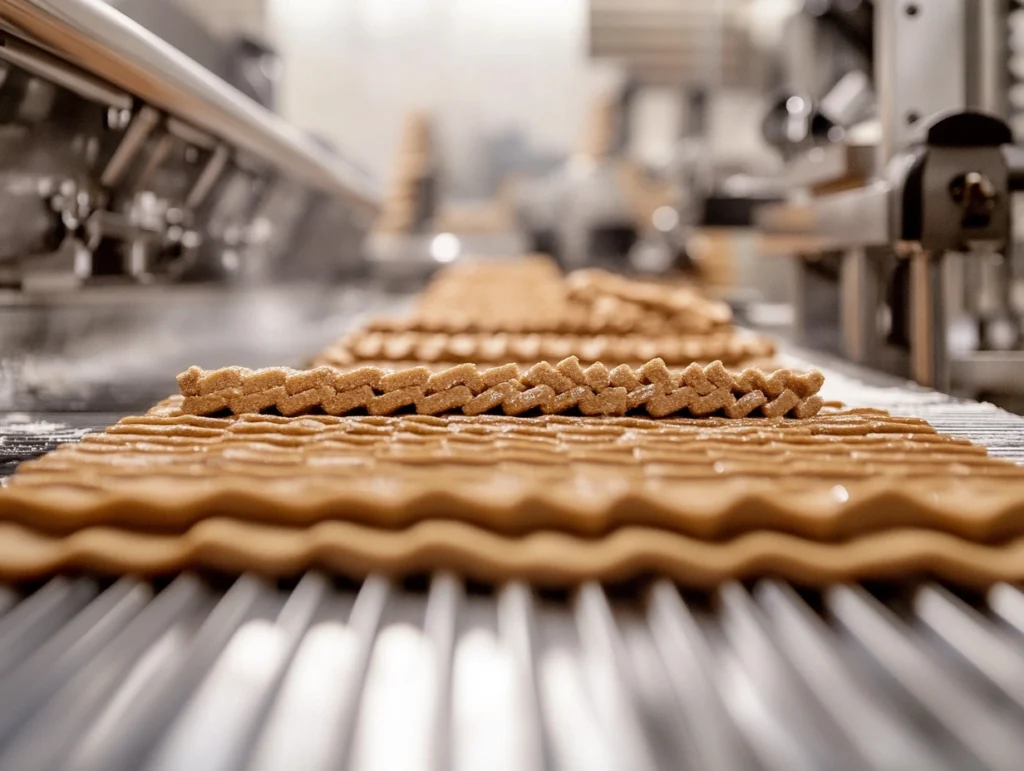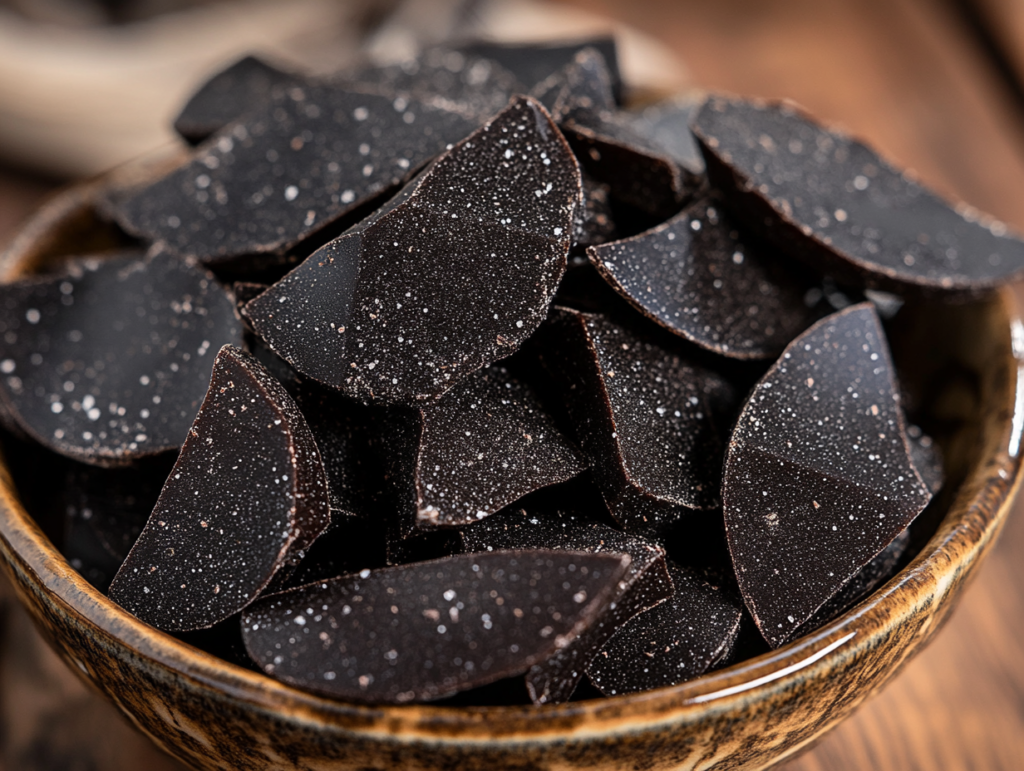Introduction
Lakkrís Djöflar, or “licorice devils,” represents a bold and unique candy that Icelanders cherish. Understanding the Lakkrís Djöflar ingredients reveals how licorice extract, salmiak, and sweet or salty fillings create its iconic taste. Licorice enthusiasts worldwide continue to explore this treat for its daring flavor combinations.
Understanding the ingredients of Lakkrís Djöflar offers insight into why it has become such a cultural staple. Whether you’re a fan of licorice or exploring Icelandic candies for the first time, learning about these ingredients can deepen your appreciation for this iconic treat. This guide dives into its composition, production, cultural significance, and how it compares to other licorice varieties around the world.
2. Understanding Lakkrís Djöflar
2.1 Definition and Origin
Lakkrís Djöflar, or “licorice devils,” is a confection made by combining licorice candy with a filling that can range from salty salmiak to creamy chocolate. The candy is known for its striking contrast of flavors: the sweetness of licorice paired with bold, salty, or even spicy undertones.
The name “Djöflar” (meaning “devils”) reflects the intensity of the flavors, which can be overwhelming for first-time tasters but addictive for those who love bold tastes. The origins of Lakkrís Djöflar lie in Iceland’s deep-rooted love for licorice, which dates back to the early 20th century when imported licorice candies became widely available in Nordic countries. Over time, Icelandic confectioners began to experiment with unique combinations, resulting in the creation of this popular treat.
2.2 Popularity in Icelandic Culture
Lakkrís Djöflar occupies a central role in Icelandic candy culture, where licorice is a national obsession. Icelanders consume more licorice per capita than almost any other country, and Lakkrís Djöflar has become a go-to choice for those seeking bold flavors.
The candy is often enjoyed during holidays, celebrations, or as a snack. Its cultural significance is reflected in its availability across Iceland, from small local shops to major supermarkets. Icelanders often share Lakkrís Djöflar with tourists as a way to introduce them to local flavors, making it a symbol of Icelandic identity.
3. Ingredients Breakdown
3.1 Primary Components
The ingredients of Lakkrís Djöflar vary slightly depending on the manufacturer, but they generally include:

Alt Text: Ingredients for Lakkrís Djöflar, including licorice extract, salmiak, sugar, wheat flour, and cocoa powder.
- Licorice Extract: The core flavor of the candy, derived from the root of the licorice plant (Glycyrrhiza glabra). This extract provides a naturally sweet and earthy taste.
- Sugar and Glucose Syrup: Used to sweeten the licorice base and balance the intense flavors.
- Wheat Flour: Adds structure and chewiness to the candy, making it firm but pliable.
- Ammonium Chloride (Salmiak): A key ingredient that gives Lakkrís Djöflar its signature salty and tangy taste.
- Natural and Artificial Flavorings: These enhance the overall flavor profile, with some recipes including hints of vanilla or caramel.
- Cocoa Powder (optional): In some variations, chocolate or cocoa powder is added to the filling for a sweet contrast.
- Food Coloring: Provides the candy’s characteristic black hue, often achieved using natural or artificial colorants.
3. Ingredients Breakdown (Continued)
3.2 Role of Each Ingredient
Each ingredient in Lakkrís Djöflar serves a specific purpose, contributing to the candy’s unique texture and flavor profile:
- Licorice Extract: This is the heart of the candy. Extracted from the root of the licorice plant, it delivers a natural sweetness and earthy bitterness that defines the candy. In addition to its taste, licorice extract is known for its potential health benefits, such as soothing sore throats and aiding digestion.
- Sugar and Glucose Syrup: These sweeteners balance the intense flavor of the licorice and salmiak, ensuring the candy isn’t overwhelmingly bitter or salty. Glucose syrup also prevents the candy from crystallizing, maintaining its chewy texture.
- Wheat Flour: As a binding agent, wheat flour gives Lakkrís Djöflar its distinctive chewiness. It also ensures the candy holds its shape during the manufacturing process.
- Ammonium Chloride (Salmiak): A staple in Nordic licorice, salmiak delivers the salty tang that sets Lakkrís Djöflar apart from other licorice candies. While it’s an acquired taste for many, salmiak is adored by licorice enthusiasts for its bold and tangy flavor.
- Natural and Artificial Flavorings: These flavors are used to enhance the complexity of the candy. Vanilla adds warmth, while caramel can create a subtle sweetness. In some variations, spicy elements like chili are added for a fiery kick.
- Cocoa Powder: Commonly found in filled variations, cocoa powder or chocolate fillings offer a rich, creamy contrast to the licorice and salmiak.
- Food Coloring: The black color of Lakkrís Djöflar is a hallmark of licorice candies. Many manufacturers use natural dyes like activated charcoal or synthetic colorants to achieve this effect.
3.3 Variations in Recipes
Lakkrís Djöflar comes in many forms, depending on the manufacturer or regional preferences. Some popular variations include:
- Classic Salty Lakkrís Djöflar: Featuring a pure licorice base and a salty salmiak filling.
- Sweet Lakkrís Djöflar: Incorporating more sugar and a mild filling, such as vanilla or caramel, for a sweeter flavor profile.
- Chocolate-Covered Djöflar: A modern twist that combines licorice with a chocolate coating, offering a decadent treat.
- Spicy Variants: For the adventurous, these versions include chili or pepper-infused licorice for a fiery flavor.
These variations showcase the versatility of Lakkrís Djöflar and cater to different tastes, from those who enjoy the classic salty punch to those seeking a sweeter experience.
4. Production Process
4.1 Manufacturing Steps
Manufacturers prepare the licorice base by combining licorice extract, sugar, glucose syrup, and wheat flour into a pliable dough. Machines shape the heated dough into long ropes and cut them into bite-sized pieces.
For filled versions, another machine injects salmiak paste or chocolate into the hollow centers of the licorice pieces. After coating the candies with salmiak powder or sugar crystals, producers ensure the flavor and texture meet quality standards.

Alt Text: The production process of Lakkrís Djöflar showing dough shaping, cutting, and filling steps.
Workers heat the licorice dough before feeding it into machines that shape it into long ropes.
Technicians monitor the machines as they inject creamy fillings like salmiak or chocolate into the hollow licorice pieces.
Quality assurance teams inspect the candies after coating them with salmiak powder or sugar crystals.
Finally, workers package the candy into airtight bags to preserve its flavor and freshness.
4.2 Quality Control Measures
Producers of Lakkrís Djöflar adhere to strict quality control protocols to ensure consistency and safety:
- Flavor Consistency: Samples from each batch are tested to ensure the flavors are balanced and true to the recipe.
- Ingredient Sourcing: High-quality licorice extract and salmiak are sourced to maintain authenticity.
- Health Regulations: Manufacturers comply with food safety standards, ensuring the candy is free of contaminants and allergens.
5. Comparing Lakkrís Djöflar to Other Licorice Candies
5.1 Dutch Licorice
Lakkrís Djöflar and Dutch licorice share a key ingredient: salmiak. However, there are distinct differences between the two:
- Flavor Intensity: While both candies are salty, Dutch licorice often leans towards a more balanced blend of sweet and salty. In contrast, Lakkrís Djöflar is bolder, often pairing salmiak with additional fillings or flavors like chocolate.
- Texture: Dutch licorice is typically firmer and chewier, with a denser consistency. Lakkrís Djöflar, especially filled varieties, can have a softer texture due to the creamy or paste-like fillings.
- Cultural Associations: Dutch licorice is a staple across the Netherlands and is available in a wide variety of shapes, from coins to buttons. Lakkrís Djöflar, however, is unique to Iceland and is often associated with local traditions and Icelandic pride.
Despite their differences, both candies are beloved in their respective regions for their bold flavors and salmiak-forward profiles.
5.2 General Licorice Candies
When comparing Lakkrís Djöflar to traditional licorice candies from around the world, a few differences stand out:
- American Licorice: Typically sweet, American licorice lacks the salty punch of Lakkrís Djöflar. Popular brands like Twizzlers or Red Vines focus on fruity flavors rather than salmiak or intense licorice extract.
- Nordic Licorice: While Nordic countries like Sweden, Denmark, and Finland also produce salmiak-based licorice, Lakkrís Djöflar stands out for its range of fillings and variations.
- Australian Licorice: Known for its soft texture and mild sweetness, Australian licorice (like Darrell Lea) is closer to dessert candy, unlike the bold and complex flavors of Lakkrís Djöflar.
Lakkrís Djöflar is a niche product that appeals to those who appreciate the adventurous and unconventional side of licorice. Its intense flavors and creative combinations make it a standout in the global licorice market.
6. Health Considerations
6.1 Nutritional Information
Lakkrís Djöflar, like most candies, is meant to be enjoyed in moderation. Here’s a breakdown of its typical nutritional profile (per 100 grams):
| Nutrient | Approximate Value |
|---|---|
| Calories | 350-400 kcal |
| Sugar | 50-60 grams |
| Protein | 2-3 grams |
| Fat | 0-5 grams (depending on filling) |
| Sodium | 150-300 milligrams (from salmiak) |
The high sugar content adds sweetness to balance the licorice’s intensity. Salmiak contributes sodium for a bold salty flavor. The recipe incorporates wheat flour for structure, while additional flavorings round out the candy’s profile.
6.2 Potential Health Impacts
Some of the ingredients in Lakkrís Djöflar have specific health implications:
- Licorice Extract: Excessive consumption of licorice can lead to elevated blood pressure due to its active compound, glycyrrhizin. Individuals with heart conditions or hypertension should consume it sparingly.
- Ammonium Chloride (Salmiak): While salmiak is safe in moderate amounts, overconsumption can cause stomach discomfort or irritation in sensitive individuals.
- Sugar Content: The candy’s high sugar levels can contribute to weight gain and dental issues if consumed excessively.
6.3 Consumption Recommendations
To enjoy Lakkrís Djöflar responsibly:
- Limit your intake to a small handful at a time.
- Pair it with other foods to balance its intense flavors.
- Avoid consuming large quantities if you’re sensitive to salmiak or licorice extract.
7. Frequently Asked Questions (FAQs)
7.1 What are the ingredients in Dutch licorice?
Dutch licorice is known for its unique combination of ingredients that deliver a balanced sweet and salty flavor. The typical components include:
- Licorice Extract: Provides the distinct licorice flavor.
- Sugar and Glucose Syrup: Add sweetness to balance the intensity of the licorice.
- Ammonium Chloride (Salmiak): Adds a salty and tangy flavor, similar to Lakkrís Djöflar.
- Gelatin or Agar-Agar: Used as a binding agent to give the candy its chewy texture.
- Flavor Enhancers: Ingredients like anise or fennel may be added to round out the flavor profile.
Dutch licorice often varies in texture, from firm and chewy to soft and pliable, depending on the recipe and brand.
7.2 What are the ingredients in licorice?
Licorice candies, in general, are made using the following key ingredients:
- Licorice Root Extract: The primary source of flavor.
- Sweeteners: Sugar, corn syrup, or molasses are commonly used.
- Flour or Starch: Helps create the candy’s structure and texture.
- Binders: Gelatin or pectin for chewiness.
- Flavoring Agents: These may include vanilla, anise, or fruit concentrates, depending on the variety.
Licorice candies come in many forms, from classic black licorice to fruity twists and salty salmiak varieties like Lakkrís Djöflar.
7.3 What is Djöflar?
“Djöflar” translates to “devils” in Icelandic, a fitting name for this bold and intense candy. The term is used to describe the strong, salty, and sometimes spicy flavors that make Lakkrís Djöflar so unique. The “devils” label reflects the candy’s daring flavor profile, which challenges and delights the palate.
7.4 Why do the Dutch eat so much licorice?
The Dutch consume more licorice per capita than any other nation, with an average of 4 pounds per person annually. This love for licorice can be traced back to:
- Cultural Heritage: Licorice has been a popular treat in the Netherlands for centuries, with records dating back to the Middle Ages.
- Taste Preference: The Dutch have a strong preference for bold, unique flavors, including salty and sweet combinations.
- Health Beliefs: In the past, licorice was thought to have medicinal properties, such as aiding digestion and soothing sore throats.
Today, licorice remains a staple in Dutch candy culture, available in countless shapes and flavors, from mildly sweet to intensely salty.
8. Cultural Significance and Consumption
8.1 Role in Icelandic Cuisine
Icelanders often enjoy Lakkrís Djöflar during holidays or as an everyday snack. Many Icelanders introduce the candy to tourists as a way of sharing local flavors. Outside Iceland, adventurous eaters seek Lakkrís Djöflar for its daring taste, especially through specialty stores or online retailers.

Alt Text: A bowl of shiny black Lakkrís Djöflar candies with creamy fillings visible in some pieces.
This candy is particularly popular during holidays and festivals, where its bold flavors often spark conversations and laughter. It’s also a favorite souvenir for tourists who wish to take home a taste of Iceland. Lakkrís Djöflar’s iconic combination of licorice and salmiak is a reflection of Icelanders’ appreciation for robust and unique tastes.
8.2 International Perception
Outside Iceland, Lakkrís Djöflar has a niche but devoted following among licorice enthusiasts. Nordic licorice candies are often viewed as an acquired taste, with salmiak flavors polarizing international audiences. However, Lakkrís Djöflar has started to gain attention thanks to the growing popularity of artisanal and exotic candies.
In countries like the United States and the UK, Lakkrís Djöflar is often introduced through specialty stores or online retailers. Food bloggers and influencers frequently highlight the candy for its “love it or hate it” appeal, making it a talking point among adventurous eaters.
9. Conclusion
Lakkrís Djöflar is a bold and distinctive confection that showcases the creativity and daring flavor preferences of Icelandic cuisine. By combining licorice with salty, sweet, or even spicy fillings, this candy has carved out a unique place in both Icelandic and global candy culture.
Understanding the ingredients of Lakkrís Djöflar provides insight into its texture, flavor, and appeal. From licorice extract and salmiak to cocoa and caramel, each component contributes to the candy’s complex profile. While it might not suit everyone’s taste, Lakkrís Djöflar remains a testament to the rich culinary traditions of Iceland.
Whether you’re a seasoned fan of licorice or a curious newcomer, Lakkrís Djöflar offers an unforgettable candy experience. Its intense flavors, cultural significance, and growing international popularity ensure it will remain a beloved treat for years to come.
